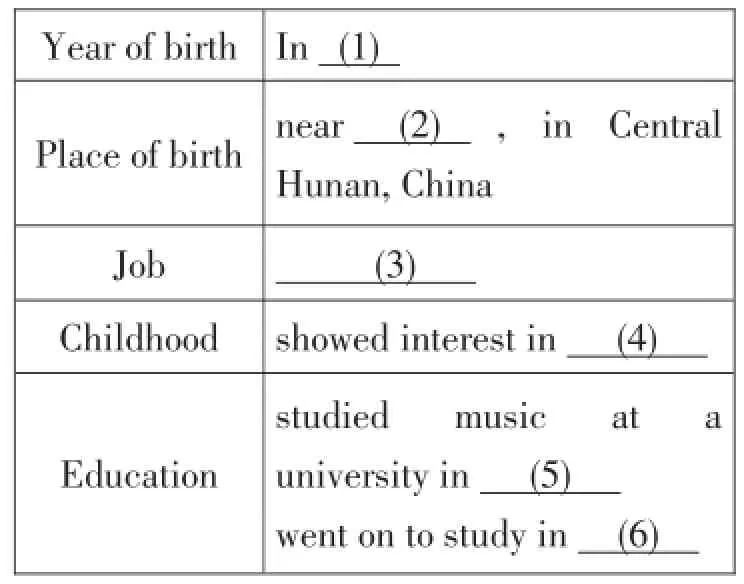■邱美春
初中英语阅读活动的分析与重构
——以三节同题异构课为例
■邱美春
当前,读前、读中、读后三阶段教学模式和略读、寻读、细读等阅读策略的运用成为阅读教学的模板,然而这类模式只有形式没有内涵,使一线课堂的阅读教学日益僵化。本文以公开课中的教学片断作扫描对象,分析存在的不足,对教学活动的设计进行了重构,使阅读活动从单一的、浅层的、散乱的转向关联性、深层性、综合性。
阅读教学深层理解思维发展
阅读是学习者获得语言输入的重要途径,阅读教学是初中英语教学的重点。目前,许多教师在阅读教学实践中采用PWP阅读教学模式。但是,过于模式化的教学也使阅读教学日益僵化。在苏州市吴江区一次三校共同体联合教研活动上,三位教师同题教授译林版《英语》九年级上册Unit5 Reading:Music without boundaries的第一课时。看似skimming、scanning和careful reading活动都有,一线教师也为自己能够跟上阅读教学的模式而欣喜,笔者却觉得存在着问题。本文以三节公开课的教学片段作扫描对象,分析不足,对教学活动设计进行重构。
一、读前准备,激活图式,形成阅读期待
片段1 Pre-reading:Watch a short video about the music for the Beijing Olympics and get some information about Tan Dun and his music.
教师用PPT依次呈现北京奥运会标识、北京奥运会颁奖现场视频、演奏颁奖音乐的视频等。边问边呈现生词(见划线部分):
Have you seen this logo?(Yes,it’s the logo of 2008 Beijing Olympic Games.)
Have you heard of this music?(Yes,it’s Molihua.)
You know,the music was played each time a medal was presented to a winner.
What instruments do you see in the video?(Piano,cello,drum,guitar,Chinese ancient bell.)
Who wrote the music?(Tan Dun)
What is Tan Dun?(He is a composer.)
Let’s know more about Tan Dun.
教师由此导入阅读环节。
【分析】阅读准备活动要贴近学生生活,激活学生已有的背景知识,激发学生的阅读兴趣。本片段通过播放2008年北京奥运会的颁奖视频,创设了情境,带出了词汇,激活了学生的内容图式,建立了学生的语言图式,引入了本节课的主题——著名作曲家谭盾。然而,无论谭盾这个人物还是其音乐作品,学生对其并不十分熟悉。过于快速地导入课文,令学生有点猝不及防。大部分英语教科书都有丰富的彩色插图,照顾到了中小学生的认知偏好和身心发展特点,这是不可错失的资源。教师若能够插入读取插图信息和根据标题预测内容的环节,不失为一个过渡的好方法。
【重构】在片段1后,延长导入环节。
Who is Tan Dun?(呈现插图)He is Tan Dun.
What can you see in the picture?(He is holding an Oscar.)
Is he excited in the picture?(Yes,he is.)
What did he win the Oscar for?(He won it for his music in a film.)
Today,the title of the article is Music without boundaries.Can you predict what the article is about?
围绕标题,学生可能作如下预测:
It is about whose music is without boundaries.
It is about what boundaries his music is without.
Itisaboutwhyhismusiciswithout boundaries.
预测是一项重要的阅读技能,有助于培养学生的想象力和逻辑思维能力。无论预测结果准确与否,预测都能使学生更接近文本主题。
二、读中理解,循序渐进,获取深层信息
(一)略读——获取大意,突出整体性。
片段2 Skimming:Read the article quickly and get the main idea about the article.As a composer,what is Tan Dun best known for?
三位教师导入新课后,设计略读环节,问学生:As a composer,what is Tan Dun best known for?学生读一遍课文后,在文中找到答案:He is best known for the music in the film Crouching Tiger,Hidden Dragon.
【分析】我惊诧于三节课竟然出现了完全一样的设计,突然意识到:这肯定是网上“参考”来的。很多教师在进行教学设计时,不是先自己思考,而是先去找课件模仿,不管正确与否,这对教学都是无益的。从活动看,教师对“Skimming for the main idea”的理解是偏颇的。略读是以较快的速度抓住文章梗概的阅读方法,“As a composer,what is Tan Dun best known for?”这个问句不足以体现文章的大意。对于初中学生而言,略读环节旨在培养学生抓住文本主题和框架结构的能力,让学生对全文形成初步的整体理解,使学生快速地进入文本阅读。要获取文章大意,可采取提问、填空、匹配、自主归纳等方法,查找段落主题句或关键词。
【重构】What is it about in each paragraph?Skim the article,and match the paragraph with its main idea or keyword.
Para.1a.Tan Dun’s achievements
Para.2b.Tan Dun’s music Water
Para.3c.Tan Dun’s childhood
Para.4d.Tan Dun’s musical style
Para.5e.Tan Dun’s education
Para.6f.Tan Dun’s award music
(keys:Para.1—f;Para.2—c;Para.3—e;Para. 4—b;Para.5—a;Para.6—d)
学生略读完后,对语篇有个大致理解,这比就回答一个问题的“性价比”高多了,而且学生了解了篇章中信息的分布,便于他们在寻读环节中对细节的查找和定位。
(二)寻读——抓住线索,突出层次性。
片段3 Scan the article and complete the notes.
Tan Dun
Year of birth:(1)
Place of birth:(2)
Interests:(3)
Job:(4)
Education:studied music at a university in(5)
went on to study in(6)
Best known for:winning an(7)for the music in a film.
His music:uses(8)a lot
build a bridge(9)
学生再读课文,完成教材配套练习B2。
【分析】Scanning是寻找细节的阅读方法,首先要确定与所找内容相关的关键词,然后扫读材料,碰到关键词时放慢阅读速度,仔细阅读关键词前后的信息,确定要找的内容,定位哪些信息是值得推敲的,切忌东一榔头西一锤、杂乱无章的罗列,要把信息之间的相互关系建构起来。
此练习是教材中的配套练习。这个练习是关于Tan Dun’s profile,涵盖了谭盾的出生年份、出生地、兴趣爱好、工作、教育、成就及音乐方面的基本信息。但我认为这个表格对本文的主体内容——谭盾的音乐不够突出,为使学生有个更清晰的概念,可以再作调整。
【重构】Who is Tan Dun?Scan the article,and finish Tan Dun’s profile.
(A)About Tan Dun

Year of birth Place of birth near(2),inCentral Job Childhood showed interest in(4)Hunan,China(3)Education studiedmusicata university in(5)In(1)went on to study in(6)
(B)About his music

Beijing 2008 Olympic Games(7)music Representative music winning an(8)for the music in a film amazing piece(9)uses the Achievements sounds of nature a lot builds a bridge(10)
KEY:⑴1958;⑵Liuyang River;⑶composer;⑷music;⑸Beijing;⑹the USA;
⑺award;⑻Oscar;⑼Water;⑽between the East and the West
这样,要填写的内容没有过多增加,而信息更加完整,基本包括了文章中重要的具体细节,并体现了前后的层次性。
(三)细读——分析归纳,突出综合性
片段4 Careful reading
Read Para.1,put the proper words in the blanks.
Tan is a great_________.He wrote the ________for the Beijing 2008 Olympic Games,Each time___________to a winner,the award music was played.
Read Para.2,answer the following questions.
1.When and where was Tan Dun born?
2.What does he love?
3.Did he use any musical instruments?
4.What did he make music with?
Listen to Para.3,is it true or false?
()1.Tan Dun received both Eastern and Western musical education.
()2.Tan Dun went on to study in the USA in 1985.
Read Para.4,choose the correct answer.
()What kind of musical instruments are used in the piece of music Water?
A.waterB.many musical instruments like violin
How does Tan Dun do it?
Read Para.5&6,read and discuss in groups: What does Tan Dun mean by saying“My music is to dream without boundaries”?Give examples if necessary.
【分析】Careful reading旨在深入理解标题与段落、句子、词汇之间的关系,理清文本的脉络,抓住文本的主旨,真正理解作者的写作意图和文本中蕴含的逻辑关系。本课正是进行“细读”的一个典型文本。三位教师以为第一课时侧重于文本的理解,对于单词或结构等语言现象丝毫不敢涉及。事实上,在英语阅读教学中,教师可以借助文本细读的方式对文本语言进行咀嚼,从而让学生获取对文本词句含义、结构层次、情感意境、写作技能和作者观点等深入的理解和感悟。
【重构】Watch the video of the article,finish the following sentences or answer the questions.
Activity1:What does the writer think of Tan Dun and his music?
(The music was written by Tan Dun,a worldfamous composer.
As a composer,perhaps he is best known for winning an Oscar for his music in the film Crouching Tiger,Hidden Dragon.
His amazing piece of music Water does not use any musical instruments.
He has successfully brought Chinese and Western music together.)
Activity 2:
1.How did Tan Dun make the music Water?Why could he make such an amazing piece of music?
2.Is the award music very important at the Olympic Games?Why was it written by Tan Dun at the Beijing Olympics?
3.Is Tan Dun’s music without boundaries?Give examples if necessary.
本环节旨在通过教师的精心设问,引领学生对文本细节进行深层次解读。Activity1引导学生通过抓住关键词来理解作者的观点和写作的意图。Activity2通过3个问题,引导学生经过分析归纳,将谭盾的作品、音乐的风格以及成就的取得贯穿起来,凸显文本的核心主线,并以问题链的信息梳理为基础,层层铺垫,环环相扣。
三、读后内化,初步运用,培养思维能力
片段5 post-reading:
[课1]:Tell your friends about Tan Dun’s music.
[课2]:What do you think of Tan Dun’s music?
[课3]:Suppose you’re Tan Dun,and you’re invited to class.The other students will ask questions about your life and your works.
【分析】许多教师认为,作为一个读后环节,一定要设计一个“高大上”的问题。从三节课的教学效果看,由于读中理解环节、处理细节信息多,解读深层含义少,学生只能理解文本字面的意思,做到“read the lines”,而做不到“read between the lines”,更不用说“read beyond the lines”。[课1]和[课2]上,学生说来说去就是书上的原句,而不会用自己的语言转述。[课3]上,学生能问和能讲的基本也是谭盾何年何地出生、何年进入大学等信息。学生只是把书上的信息再翻炒一遍,而无其他新意。笔者认为,两个课时应作为一个连贯的整体,在过渡衔接和有效整合方面作通盘考虑。
【重构】The article begins with Beijing 2008 Olympic Games award music instead of introducing Tan Dun.Do you agree with the writer?Why or why not?
How would you write a short passage about Tan Dun if you were writers,too?Work in groups of four,then present your passage.
这样的活动,类似于“任务”,有布置、有过程、有结果,比单纯的复述课文更有意义,给学生更多的参与感,既借用文章中的语言,又不拘泥于文本中的语言,能提高学生思维的发散性和创新性。四人一组的小组活动提供了学生互帮互学、合作探究的机会,成果的展示增强了学生的成就感。
总之,阅读教学虽有模式可依,但只有形式而没有内涵的活动犹如“走过场”。教学阅读第一课时,应时刻关注阅读过程本身,最核心的问题就是阅读和理解文本,包括对语言知识的关注、文本信息的理解以及对文本深层次的挖掘与探究。教师既要给予学生充分的阅读时间,又要设定有层次的阅读任务,这样的阅读教学将带给学生完全不同的阅读体验。
(作者为江苏省苏州市吴江区教育局教研室英语教研员)



